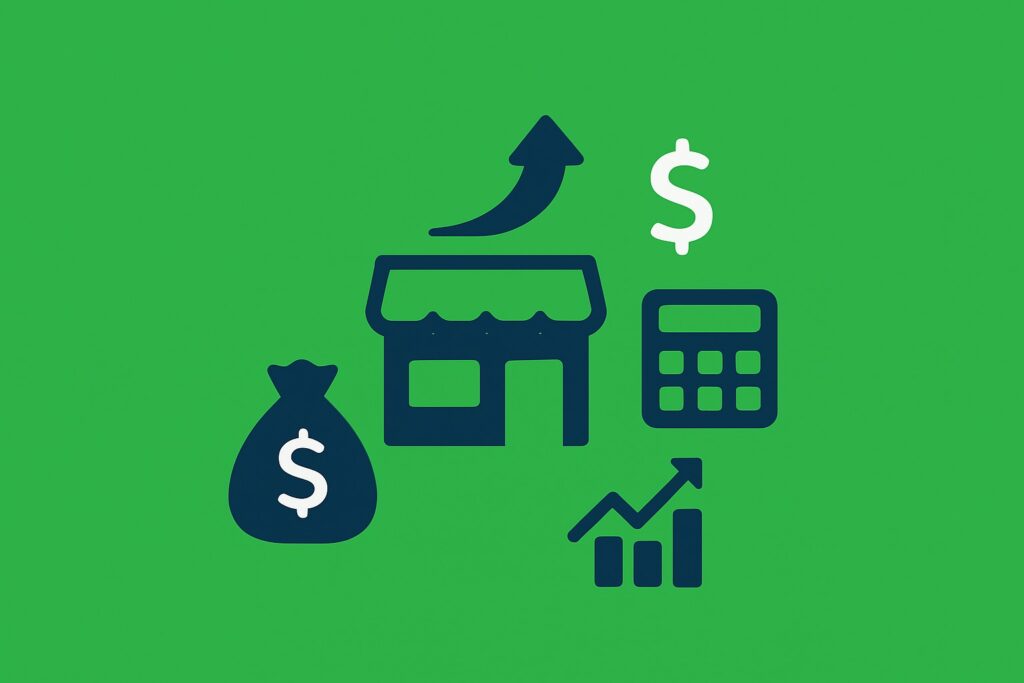Our goal at Lending Valley is to provide all small business owners access to the best loans possible for their business. You can rest assured we will get you the best rates in the market!

If you’re planning to borrow or raise capital in 2025, it’s important to look beyond the amount and interest rate. What truly matters is how that Smart Business Financing Impacts Cash Flow and limit or enhance your flexibility in the long run. Many business owners make the mistake of chasing the lowest rate, only to find their repayments drain liquidity and restrict growth. The best deal is the one that supports your operations without putting pressure on your working capital.
In this blog, we’ll break down how different repayment obligations influence monthly or weekly cash flow, how alternative options like merchant cash advances (MCAs) can reshape flexibility, and what future opportunities certain funding types may limit. We’ll also share recent 2025 data and case studies that show how smart financing choices can help sustain both short-term stability and long-term freedom.
When you take on financing, it’s not only about how much you get—it’s about Smart Business Financing Impacts Cash Flow. Every repayment plan influences your cash flow rhythm. A monthly schedule may feel manageable, but it still requires consistent revenue. Weekly or daily repayments, on the other hand, can tighten your operational breathing room, especially if your income fluctuates.
In essence, repayment terms decide whether your financing becomes a growth tool or a stress factor. The more frequent the payments, the less time your business has to recover between outflows. That’s why understanding the repayment structure upfront is critical before signing any agreement—it shapes your short-term stability and long-term flexibility.
In simple terms:
• Monthly = predictable but rigid during low sales.
• Weekly = moderate flexibility, requires steady inflow.
• Daily = high pressure, minimal buffer for fluctuations.
• Longer-term loans = smoother cash flow, less strain.
A retail chain secured a 12-month working capital loan in early 2025 with monthly repayments. During months three and four, sales slowed sharply. Because the payment amount was fixed, the company had to pull from reserves and postpone a marketing campaign.
Takeaway: Predictable payments bring structure but reduce flexibility when revenue dips.
An online retailer used a revenue-share financing model, remitting 10 % of daily card sales. When sales dipped, daily deductions quickly strained cash flow. They missed early-payment supplier discounts—raising their overall cost of goods.
Takeaway: High-frequency payments can deplete short-term cash, limiting agility and increasing expenses.
A manufacturing company financed equipment with a 20-year fixed-rate loan in 2025. Their monthly installments were small compared to their cash inflow, leaving them room for surprise maintenance and investment.
Takeaway: Structured long-term debt preserves flexibility, helping businesses stay resilient when conditions change.
The Federal Reserve’s 2024–2025 survey revealed that more firms than before reported uneven cash flow and difficulty covering expenses (PhiladelphiaFed.org). In short, repayment frequency now plays a bigger role than ever in determining a firm’s real-world flexibility.
Revenue-sharing and non-traditional financing models like Merchant Cash Advances (MCAs), invoice factoring, and daily remittance loans are designed for quick access to funds—but they can create ongoing strain on your cash flow. Unlike traditional loans with fixed monthly payments, these options tie repayments directly to your revenue, often on a daily or weekly basis. That means when sales dip, your repayment doesn’t stop—it just takes a bigger bite out of a smaller pie.
For instance, an MCA typically requires remitting 5–12% of your daily card sales. It may feel manageable when business is booming, but during slower periods, you’re still locked into that revenue percentage. This can squeeze your liquidity, leaving less room for essentials like payroll, supplier payments, or growth investments. While MCAs and similar products promise speed and convenience—often funding within 24–48 hours—the trade-off is steep: high effective costs and reduced flexibility.
Moreover, 2025 OECD data indicates that small and medium-sized enterprises (SMEs) increasingly rely on such short-term financing due to tight credit conditions and rising interest rates. However, this shift often leads businesses to prioritize immediate survival over long-term stability, sacrificing their ability to reinvest profits or build reserves.
The bottom line: fast financing can help you seize short-term opportunities, but it may erode your financial cushion. Always weigh the urgency of funds against the future strain on cash flow.
Key takeaways:
• Revenue-based repayments fluctuate with sales, reducing predictability.
• MCAs and daily remittances can erode profit margins during slow months.
• Quick approval doesn’t always mean cost-effective or sustainable.
• Flexibility often declines as payment frequency increases.
• Ideal only for businesses with steady, predictable daily sales and high margins.
• Always calculate the true cost of capital before accepting short-term relief.
Taking on financing isn’t just about the money you receive today—it shapes what you can or can’t do tomorrow. The structure, amount, and repayment terms of your financing directly influence your flexibility to reinvest, expand, or pivot when new opportunities—or challenges—arise. Here’s how it affects your future moves:
Read More: Business Financing Approval Process (USA): What Really Governs “Yes” vs “No” in 2025
When Short-Term Debt Hurts Growth:
A tech services firm took a high-interest, short-term loan in early 2025 to expand staffing. However, the repayments consumed 30% of their monthly revenue. When a major contract was delayed, the company couldn’t afford to hire new staff and had to freeze operations.
Future flexibility lost: The firm missed a contract expansion opportunity due to limited liquidity caused by rigid loan terms.
How Smart Structuring Preserved Growth:
A restaurant group opted for a fixed-rate, long-term debt plan for a new build-out, keeping monthly payments modest. This choice protected their cash flow and allowed them to reinvest profits strategically.
Future flexibility kept: With healthy liquidity, they successfully opened a second location in late 2025 without seeking additional capital.
When Daily Remittances Limit Strategy:
A subscription-box e-commerce business chose a merchant cash advance with daily revenue shares. Although it provided quick funding, the ongoing remittances reduced profit margins.
Flexibility impacted: The firm couldn’t pivot into a wholesale channel until the MCA term ended, delaying its expansion strategy.
Before taking any financing offer, it’s crucial to evaluate how it fits your real-world cash cycle. In the Federal Reserve’s 2025 survey, 59% of small businesses cited irregular cash flow as their biggest financial challenge—making pre-loan assessment more essential than ever.

Revenue trends shifting downward:
The 2025 Report on Employer Firms revealed that more small businesses reported revenue declines than gains — the first time since 2021. This reversal signals a cooling economy and tighter margins. For many firms, this means loan repayments or investor obligations now consume a larger share of limited income, increasing the risk of cash strain.
Cash flow confidence falling:
According to the U.S. Chamber of Commerce/MetLife Small Business Index, only 63% of small business owners felt confident in their cash flow during Q1 2025 — a sharp drop from 72% in late 2024. This decline underscores growing concern about meeting regular expenses and maintaining liquidity, especially for firms using high-frequency repayment models like MCAs.
Weaker financial conditions regionally:
The Federal Reserve’s 2025 Third District survey found that 64% of small employer firms rated their financial conditions as “poor or fair.” Many cited struggles with operating expenses and uneven cash flow. This finding reflects a broader national trend — businesses facing more volatility and less flexibility to absorb shocks, making financing structure more critical than ever.
Together, these statistics show that 2025 is a year of tighter credit and thinner margins. Firms must look beyond approval odds or interest rates and focus on sustainability — choosing financing that maintains cash flow resilience and operational flexibility in uncertain market conditions.
Related: 5 Myths About Merchant Cash Advances (and the Truth Behind Them)
The successful borrowing isn’t only about the loan amount, but how thoughtfully you manage it. Choosing a repayment structure that matches your revenue flow ensures you can meet obligations without straining cash. Maintaining cash reserves allows for unexpected expenses and supports growth opportunities. Avoiding rigid loan terms preserves flexibility for future financing or business decisions. By keeping payments manageable, protecting cash flow, and aligning the loan’s duration with its purpose, you not only access necessary capital but also maintain operational agility. Smart Business Financing Impacts Cash Flow long-term business flexibility, and stability.
Borrowing wisely means choosing a loan amount, term, and repayment structure that fit your business needs. It ensures you can make payments without straining cash flow. Smart borrowing also keeps options open for future growth.
Aligning repayments with revenue helps prevent cash shortages. You’ll be able to pay without affecting daily operations. It reduces financial stress and keeps the business stable.
Cash slack is a reserve for unexpected expenses or opportunities. It prevents emergencies from derailing your operations. This ensures your business stays resilient and adaptable.
It means choosing a loan duration that matches how long you’ll benefit from the funds. Short-term loans for quick needs, long-term for bigger investments. This avoids overpaying interest or tying up resources unnecessarily.
Flexible repayment allows adjustments if revenue fluctuates. You can invest in growth or manage emergencies without stress. It ensures the business can respond quickly to changes and opportunities.